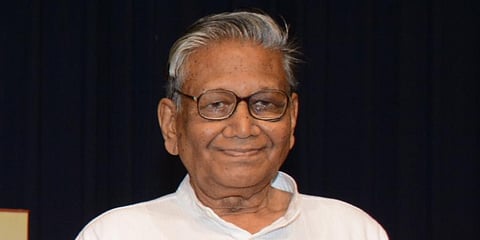

BHUBANESWAR: ‘Mo Maa ti kete bhala, jete bhala padmaphula’ were the words that Manoj Das uttered when he was unaware of alphabets or even able to fathom language or literature.
These words of unconditional love for his mother remained so etched in his memory that he remembered the moment an interviewer asked him about the time when he first started writing.
More than appreciation for his writings, admiration for the man, the writer took over in a few minutes of conversation. The most read writer didn’t fail to amaze with clarity of thought, truthfulness, sobriety and an infectious smile.
That was Manoj Das. But reminiscing Das or his writings is not as easy. A sea of work that included stories, short stories, novels and columns in Odia and English. Pick any story or a write-up and a floodgate of images, stories open up subtly shaking one’s consciousness.
The real is so starkly presented and the humble is so earth-deep in every sentence, that it soaks deep into the psyche of the reader. Presumably, that is what made the man a face in the crowd, a Padmabhusan, a Padmashri and Saraswati Samman awardee besides, Sahitya Akademi winner.
Deeply inspired by Sri Aurobindo, Das never let his ideals merge into his writings. Even when he was driven by the principles of Marxism, he maintained a margin between what he created as literature for a larger reader base.
In his own words, “In early 60s, I cut myself apart from the philosophy of communism. I was drawn into the life divine of Sri Sri Aurobindo.”
The awakening made his writings take a different direction and he never belied this. For someone who believed that inspiration plays the most important role in creative expression,
Das’ works in his own words were also inspired by the then prevailing poverty or the sight he saw at a cremation ground in Balasore at a tender age. Das’ creativity was not only limited to stories and columns for newspapers including
The New Indian Express, his contribution to Chandamama, the ever-green children’s magazine, was immense. Though then he wrote with pseudonym the popular stories of the royal life, on kings and queens, Bikram Betaal, most of the narratives were Das’.